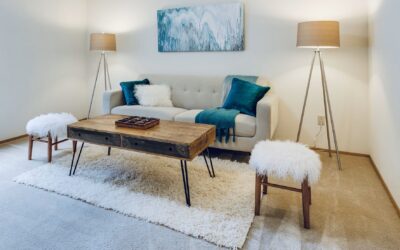Introduction: Carpet Fibres: Natural, Synthetic or Blend?
When choosing the perfect carpet for your home or office, you need to carefully consider what the carpet’s fibres are made from. This will affect the appearance, texture, durability and ease of maintenance of the carpet. Also, for more environmentally conscious consumers, different fibres have different degrees of environmental impact. In this guide, we aim to take you through the most common carpet fibres available splitting them into three categories (Natural / Synthetic / Blend) to help you select the perfect carpet for your space!
Natural
As the name suggests, natural carpet fibres are made from organic products.
• Wool: Widely-considered the premium carpet fibre of choice, wool creates a soft and luxurious feeling underfoot. Wool is also naturally stain-resistant improving the carpet’s resilience and making maintenance easier. However, these premium features come with a matching price tag, as wool is one of the most expensive carpet fibres. It is also one of the most environmentally friendly, both in terms of creating the carpet and destroying it when its life is over.
• Sisal: Made from plant fibres, this carpet is much rougher than wool making it suitable for commercial spaces with heavy footfall. This carpet fibre would suit a company wanting to promote their environmentally friendly policy.
• Cotton: A natural fibre that offers a soft feel underfoot, but is prone to staining and crushing, so not suitable for high spill or high traffic areas.
• Silk: Probably the ultimate luxury carpet, silk is incredibly soft underfoot and not suited for high traffic areas.
• Jute: A tougher natural fibre meaning jute can handle heavier traffic but does not feel as soft underfoot. It does however provide a wonderful natural-looking finish.
• Seagrass: Like jute, seagrass is tougher but rougher underfoot. It offers a natural finish, but often requires specialist care (like jute).
Synthetic
Synthetic fibres are man-made, artificial fibres made from inorganic materials.
• Nylon: Probably the most common synthetic carpet material, nylon is incredibly durable and resistant making it an excellent choice for high traffic or high spill areas. Nylon also benefits from a wide range of colour and pattern choices available, so there will surely be a nylon carpet that suits your style. With lots of styles comes lots of prices, lower quality nylon carpet is very affordable but may fade and compress over time. Whereas higher quality nylon carpet is more expensive but is well worth the investment for its superior wear resistance.
• Polyester: Polyester carpets look luxurious and feel soft underfoot. They are also stain-resistant thanks to their synthetic nature and repels water well. Like nylon, polyester carpets have a wide range of colours and patterns available. However, when compared to nylon, polyester is less resilient and durable. It is usually more affordable than nylon.
• Polypropylene (Olefin): This synthetic carpet fibre is affordable and resistant to moisture making it the best carpet choice for bathrooms and conservatories. Whilst it is easy to maintain, it is not as soft underfoot and is prone to matting over time.
• Triexta (PPT): Relatively new to the market, Triexta has the benefits of stain resistance and durability whilst also maintaining a softness underfoot. This carpet fibre has proven popular in houses with pets, as the synthetic fibres can resist paws, stains and the constant vacuuming of fur whilst also maintain a warm, homely feel. Also, as far as synthetic fibres go, Triexta is environmentally friendly as the fibre is partially made from renewable resources.
Blends
Some carpet manufacturers mix the materials they use to make fibres, and these are called blends. A common blend is a nylon-wool fibre. This combines the strengths of natural fibres with the strengths of synthetic fibres. For example, a nylon-wool blend carpet has the durability of nylon and the softness of wool combined. There are other blends too, so shop around for the combination that suits your needs.
Natural vs Synthetic
Let’s pit natural fibres against synthetic fibres over a series of carpet considerations to see which fibre comes out on top.
• Cost: Natural fibres tend to be more expensive than synthetic fibres.
• Traffic: Synthetic fibres tend to be more durable than natural fibres making them better suited for high traffic areas.
• Pets: Synthetic fibres are better suited to homes with pets than natural fibres, as synthetic fibres have some moisture resistance.
• Maintenance: Synthetic fibres tend to be easier to maintain than natural fibres.
Synthetic fibres win this head-to-head dual. However, at Flooring Hut, we would encourage you to consider a blend carpet as it offers the best of both natural and synthetic fibres.
Conclusion
When it comes to choosing the perfect carpet for your home or office space, the main thing to consider is which fibre you want. Natural fibres offer softness underfoot, a touch of luxury and are environmentally conscious. On the other hand, synthetic fibres are more affordable, more durable and easier to maintain. Alternatively, you can go for the best of worlds and get a blended carpet. We hope this guide has helped you to choose the best carpet fibre for your needs.









